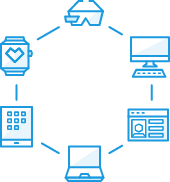>- 2017 Educational Year in Review
As we reach the end of the year, it’s important to take a look at the ideas and trends that shaped online education in 2017. What worked well enough for us to take into next year? What challenges and opportunities are emerging for 2018? Higher education is experiencing a dynamic time of not only innovation, but also calls for reform. Traditional methods are no longer sufficiently preparing students to meet their goals and develop the skills and knowledge needed in the workplace.
Technology, alternative curricula and credentialing programs, changing learner demographics, and student-focused strategies are all part of the larger conversation about improving the quality of online education and access. Continued efforts to make these improvements will have an impact on online and on-campus learning, both from the student experience perspective and that of faculty and administrators planning new academic programs and support services.
Last year, BestColleges.com surveyed 1500 current, prospective, and past online students, as well as 300 colleges that offer online programs. We wanted to find out more about why students choose online learning, as well as their experiences and expectations. We also wanted to get feedback about how schools support online students and make decisions about online programs. The result was two new reports — one for online students and another for school administrators — which included a few predictions. The realization of some are more evident than others as we reflect on higher education in 2017, but they have all been part of industry research, discussion, and practice.
Are you seeing any of the following trends in your courses, degree programs, or institutions? You’ll also find them taking hold in broader initiatives to better prepare students for college, support the college goals of a more diverse student population, and improve the experience from application to graduation for all students whether they are online or on-campus. Student success is a critical mission for colleges, employers, communities, and organizations all over the country.
Trend 1

More opportunities to choose where and how learning takes place.
What we Found
In the study we conducted last year, college students reported participating in a mix of learning formats, with more than half (52%) combining online and on-campus resources, either as required by their programs (e.g., enrolling in hybrid courses with online and in-person components) or by choice (e.g., online students visiting campus for tutoring). In a follow-up survey this year, the number increased to 64%. But this trend toward increased choice for learners, goes beyond just a blended/hybrid approach to courses and support services.
While earning a college degree is still the traditional way to enter many career fields (and required for licensure and certification for some, such as teaching and nursing), degrees are no longer the only option for postsecondary learning and career preparation. Navigating the growing number of credentialing options can be daunting, however. Initiatives like The Lumina Foundation’s Connecting Credentials hope to make the process of earning a certificate or certification, and documenting the skills developed in a specific program, more transparent for prospective students and employers alike.
Looking Ahead
As we move forward into the new year, students have more options than ever to learn in a setting that meets their needs, and in programs designed with career-related outcomes in mind. The growth of microcredentials (e.g., badges, nanodegrees) promises targeted skill development and assessment. These programs are now offered by colleges, as well as open education platforms (e.g., Udacity), private organizations, and partnerships. Also, watch for better alignment of full degree curricula with industry-preferred preparation and skills, and certification and licensure.
Trend 2

Continued use of synchronous technology tools to increase student engagement.
What we Found
More than half (53%) of the instructors responding to our survey this year identified “developing a learning community at a distance” as their biggest challenge. Adding real-time, live meetings is one strategy to overcome this. Our study last year found that more than half of online students (56%) had some requirement to meet synchronously at some point in their coursework. These meetings typically take place in a virtual classroom or web-conferencing platform that offers audio, video, text chat, and whiteboard functions. We’re seeing a slight decrease this year, with only 50% of online students reporting scheduled, synchronous components in their classes.
Live meeting tools such as Zoom, Collaborate, and Google Hangouts are widely available for use, and are sometimes embedded in the more than 150 learning management systems that offer synchronous learning options. But there are other real-time technologies emerging as a way to immerse students in a lesson, creating opportunities for enhanced interaction and engagement. Virtual reality technology is emerging in higher ed to provide a real-time environment, or simulation requiring real-time response. Ohio University’s Holodeck is used for language education and global field trips. Shaw University offers a 360-degree campus tour. Students in an English literature class at Boston College are building Joycestick, a virtual reality game to study Joyce’s novel Ulysses.
Looking Ahead
Web-conferencing tools continue to bridge a communication gap in higher education, but the possible venues for live communication are evolving. Virtual reality tools and strategies leveraging tech to create a shared experience for students and build community in college courses. These tools are also becoming easier to use, through apps like Edorble.
Trend 3

Mobile learning activities will become easier to participate in, and more widespread across the institution.
What we Found
As smartphone ownership increases these devices are used to conduct more aspects of our lives, including educational pursuits. In 2015, Pew Research Center found that 30% of smartphone users used these devices to “take a class or get educational content.” But not all colleges and universities are on board with mobile-ready websites, student portals, or course access. Our prediction was largely based on the priority college IT professionals were placing on mobile development.
Learning management systems, such as Blackboard, Canvas, and Brightspace, have apps that provide students with access to course materials via mobile device. But classes are just the beginning. What if you could access everything you need to attend or teach a course? Student resources, such as libraries (e.g., Luther College’s curated list of mobile friendly databases), administrative services (e.g., St. Petersburg College’s mobile option for registration, financial aid, campus maps), and support services (e.g., The University of Arizona’s career center app), are also going mobile.
Looking Ahead
Smartphone use shows no signs of slowing. As the demand for easier access to college resources and assistance increases, along with the capabilities of our personal devices, we’ll likely see more integrated use of mobile apps to meet the need. Higher education can also look toward the training trend of microlearning — brief, focused, just-in-time content — to make the most of mobile access. These chunked lesson strategies could allow students to focus on a single concept demonstration or reinforce an in-class lecture while they are commuting, taking a work break, or waiting in line somewhere.
Whether they are entering college for the first time as on-campus students, or pursuing advanced degrees online, the more choices institutions can provide — in terms of not only a range of learning environments, but also tools for accessing learning resources and guidance about their choices — the better we can support them on their pathways to knowledge and skill development, and employment.
BestColleges.com is committed to supporting student success and advocating quality higher education. This starts with purposeful, original research, however, our efforts to track top trends are just the beginning. In 2017 this work included gathering input from students, administrators, and agencies providing insight into the complex issues of student debt and removing barriers to student support. We also developed a comprehensive guide to assist LGBTQ students, and curated resources for Spanish-speakers and students with disabilities.
Our annual surveys to students and school administrators are underway to identify trends for 2018. We are also developing new partnerships and initiatives to expand the resources available, as well as include the voices of those most affected by current trends and issues in higher education. As we continue our research related to college decision making and career planning we’ll be sharing what we learn along the way. We hope this work can further assist your efforts to support college students.